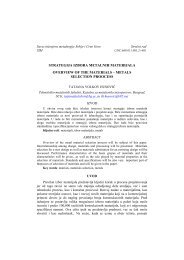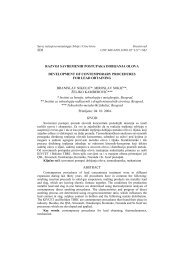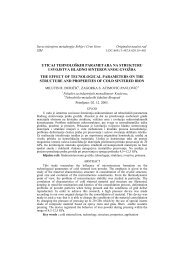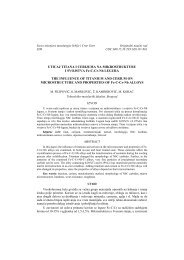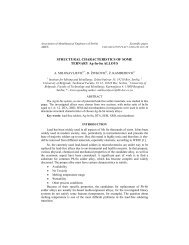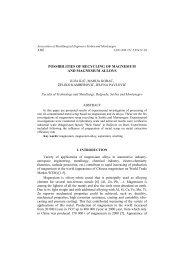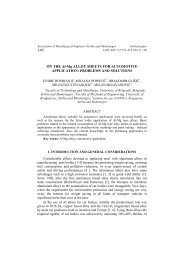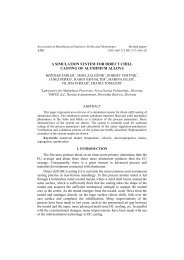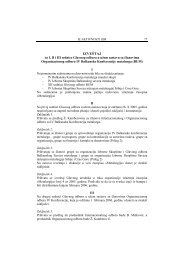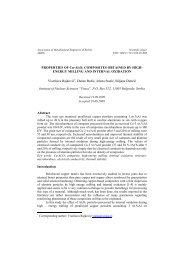THE INHIBITIVE EFFECT OF ETHANOLAMINE ON CORROSION ...
THE INHIBITIVE EFFECT OF ETHANOLAMINE ON CORROSION ...
THE INHIBITIVE EFFECT OF ETHANOLAMINE ON CORROSION ...
You also want an ePaper? Increase the reach of your titles
YUMPU automatically turns print PDFs into web optimized ePapers that Google loves.
242 Metall. Mater. Eng. Vol 18 (4) 2012 p. 241-257<br />
always spontaneously covered by an oxide film which protects the metal from further<br />
oxidation [1]. This surface film is amphoteric and dissolves when exposed to high<br />
concentrations of acids or bases [2,3]. Also, the presence of some halogen ions,<br />
especially chloride ions, may significantly destabilize the oxide film on aluminium due<br />
to its strong dissolution caused by the localized attack [1]. This kind of mechanism has<br />
been explained by replacement of water molecules by specifically adsorbed chloride<br />
ions at the surface of the dissolving metal [3]. The transfer of metal ions from the<br />
metallic phase to the solution can be explained by direct participation of chloride ion in<br />
the metal dissolution reaction [4].<br />
Aluminium and aluminium alloys are usually protected from corrosive<br />
environments by conversion coatings (phosphate, oxide, chromate, etc.) or some<br />
organic-inorganic compounds, and then topcoated with organic coatings, as a barrier<br />
layer between the substrate material and the environment [5-7].<br />
Carbon dioxide gas when dissolved in water forms carbonic acid which is<br />
corrosive to metals. Injection of film forming inhibitors has been the common method<br />
for prevention of CO 2 corrosion. Different groups of organic compounds have been<br />
reported to exert inhibitive effects on the corrosion of metals. Most of the inhibitors are<br />
organic heterocyclic compounds with N, S, or O atoms [8,9]. The sites of these<br />
elements have higher electron density, making them the reaction centers [10]. The<br />
addition of corrosion inhibitors effectively secures the metal against an acid attack. It<br />
has been found that most of the organic inhibitors act by competitive adsorption on the<br />
metal surface with the aggressive ion and by blocking the active corrosion sites [11,12].<br />
The adsorption on the metal surface is influenced by the nature and surface charge of<br />
metal, by the type of aggressive electrolyte, and by the chemical structure of inhibitors<br />
[13]. Corrosion inhibitors based on organic compounds like alkanolamine influence the<br />
corrosion process by forming an adsorptive film on the metal surface [14]. The aminoalcohols<br />
are common inhibitors and they are widely applied since they are non toxic and<br />
cost attractive [15].<br />
Ethanolamine, commonly called monoethanolamine (MEA) is an organic<br />
chemical compound that is both a primary amine and a primary alcohol and acts as a<br />
weak base [16]. The main functional groups are hydroxyl and nitrogen atom. All amines<br />
have a lone pairs of electrons. However, the readiness with which the lone pair of<br />
electrons is available for co-ordination with a proton determines the basic strength of<br />
amines [17]. The inhibitive effect of ethanolamine is achieved by donating unshared<br />
pair of electrons from nitrogen atom, followed by surface complex forming [18].<br />
In this study the inhibition effect of ethanolamine on the corrosion of aluminium<br />
in 3 wt. % NaCl aqueous solution saturated with CO 2 is discussed. In order to determine<br />
the corrosion inhibition efficiency of investigated inhibitor and the optimal<br />
concentration of inhibitor that provides the lowest corrosion of aluminium, the open<br />
circuit potential (OCP), electrochemical impedance spectroscopy (EIS), linear sweep<br />
voltametry (LSV) measurements, weight loss measurements and scanning electron<br />
microscopy technique (SEM) had been conducted.<br />
Experimental<br />
Electrochemical cell<br />
Experiments were conducted using a conventional three-electrode cell<br />
arrangement. The working electrode was pure aluminium panel (10 mm × 10 mm ×




